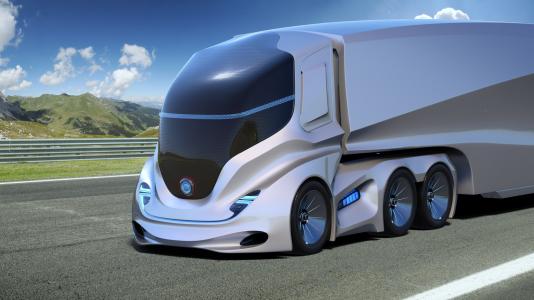
As electric vehicles grow in popularity, so do efforts to build ever-faster charging stations. But even the most ambitious plans for light-duty electric cars will not be enough for the nation’s commercial truck fleet, which needs to charge large batteries quickly to meet demanding transport schedules.
Readying the charging infrastructure necessary for a future filled with electrified medium- and heavy-duty trucks requires an unprecedented amount of coordination among equipment manufacturers, facility owners, fleet operators, utilities, automakers and other stakeholders. For the past two years, the U.S. Department of Energy’s (DOE) Argonne National Laboratory has led that collaboration, convening more than 300 industry leaders to identify key issues in the effort to go beyond fast charging for trucks and buses.
Current technology does not meet the charging power levels needed for larger commercial vehicles, which often have a much shorter charging time window to minimize truck downtime. An extreme fast charging station, for example, might have a rating of 350 to 400 kilowatts. Charging a commercial vehicle with a 1-megawatt-hour battery from 10 percent to 80 percent capacity could take at least two hours with one of these systems — the goal is to do the job in about 20 minutes while on-route for the delivery mission. Depot or home-base charging stations, on the other hand, need to accommodate many off-duty large vehicles, one after the other, charging each within three to eight hours.
So far, no standardized solution exists to meet such scenarios — even if it did, many trucks and buses aren’t designed to handle such high-power charging. In late 2018, Argonne, in collaboration with Oak Ridge National Laboratory and the National Renewable Energy Laboratory, began holding a series of industry meetings aimed at identifying and solving some of the issues involved in building megawatt-plus (MW+) multiport charging networks. The work, which is supported by DOE’s Vehicle Technologies Office, included both group meetings (virtual and face-to-face) and one-on-one conversations with subject matter experts.
“No one organization has an end-to-end view of MW+ multiport charging requirements for electric vehicles,” said Theodore Bohn, principal electrical engineer at Argonne and leader of the effort. “Each industry knows their part very well, and we need to put those different areas of expertise together to understand the whole system.”
After the first year of meetings, a report summarizing technology readiness and standards gaps was distributed for feedback.
“Having the opportunity to see the current and proposed engineering strategy from Argonne helps us prepare for some potential challenges as we look to support the electrification of vehicles,” said Homer Hogg, director, technical service at TravelCenters of America, a truck stop and travel center company that has been participating in the sessions.
This past year, the group refined that document with monthly meetings aimed at setting up validation and interoperability tests for charging systems and their various components. The working group identified five key issues that need to be addressed:
Sub-transmission Interconnection: Advanced charging systems with higher voltages can run into complicated interconnection agreements with utilities that have a long lead time. These systems also require space for load centers with circuit protection and safety requirements.
Low/Medium Voltage AC-DC Power Conversion: Few standards exist for medium-voltage AC-DC power conversion electronics, which also lack the equipment needed to convert and control power in a safe, stable way. Semiconductors with appropriate ratings for MW+ power levels are a gap, as are robust controls for the semiconductors at these voltage levels.
DC-DC Power Conversion: MW+ multiport charging systems that incorporate local generation, such as solar panels, need to decouple these systems from a common DC bus. There is a lack of standards on mechanical connections and modular packaging that could allow more scalable charging systems.
MW+-Rated Output Charging Cables/Couplers: There is a gap in standards-based vehicle charging couplers at the MW+ level. Liquid cooling of high-current conductors has not been validated, yet non-cooled charging cables can be prohibitively heavy, placing strain on the charging coupler/vehicle inlet. In addition, cord handling systems are often too short to reach trucks that are far from the dispenser.
Vehicle-Side Components: MD/HD electric trucks and buses do not have a standardized charging inlet location that could facilitate best practices on floorplan design for charging facilities, among other issues.
“We get a lot of positive feedback from people who say this isn’t one of the places, this is the place to get information on this topic,” said Bohn. In 2021, the working group will turn its attention toward implementing some of the test cases that have been designed on an interoperability testbed in collaboration with industry partners.
“Scalability is the key,” Hogg said. “Argonne’s focus on developing and testing scalable solutions should provide a good road map for organizations interested in aligning their EV charging infrastructure in markets where customers operate the vehicles.”